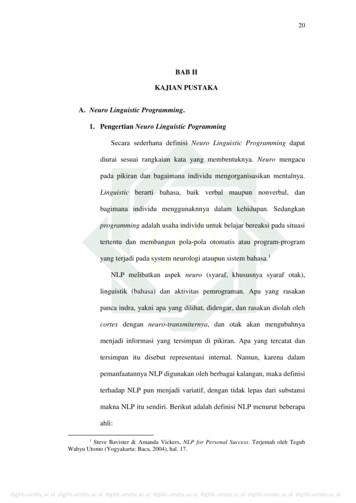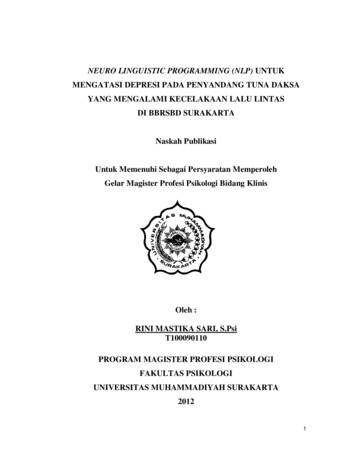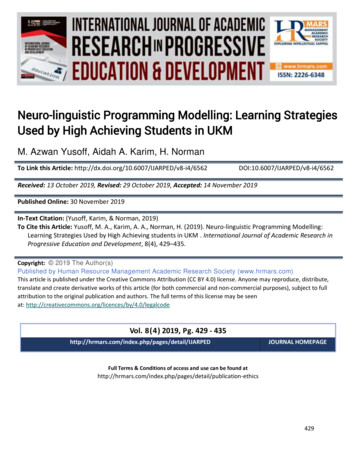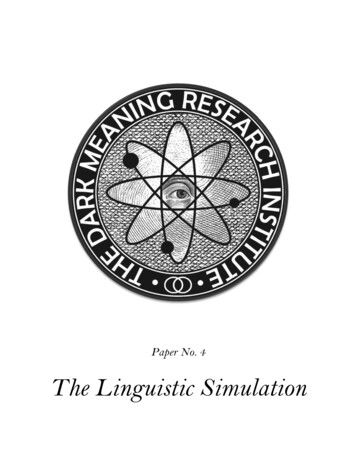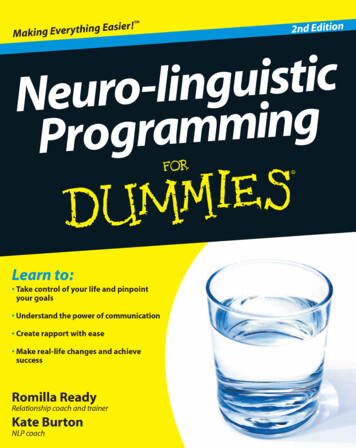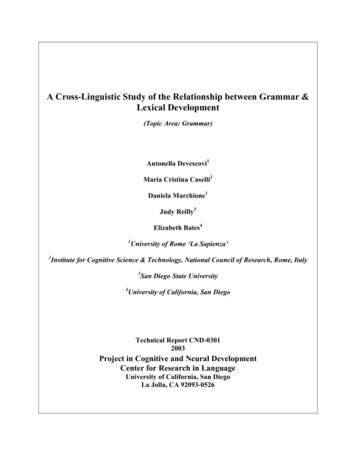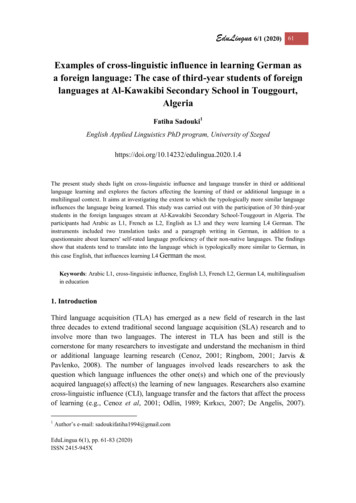
Transcription
EduLingua 6/1 (2020)61Examples of cross-linguistic influence in learning German asa foreign language: The case of third-year students of foreignlanguages at Al-Kawakibi Secondary School in Touggourt,AlgeriaFatiha Sadouki1English Applied Linguistics PhD program, University of he present study sheds light on cross-linguistic influence and language transfer in third or additionallanguage learning and explores the factors affecting the learning of third or additional language in amultilingual context. It aims at investigating the extent to which the typologically more similar languageinfluences the language being learned. This study was carried out with the participation of 30 third-yearstudents in the foreign languages stream at Al-Kawakibi Secondary School-Touggourt in Algeria. Theparticipants had Arabic as L1, French as L2, English as L3 and they were learning L4 German. Theinstruments included two translation tasks and a paragraph writing in German, in addition to aquestionnaire about learners' self-rated language proficiency of their non-native languages. The findingsshow that students tend to translate into the language which is typologically more similar to German, inthis case English, that influences learning L4 German the most.Keywords: Arabic L1, cross-linguistic influence, English L3, French L2, German L4, multilingualismin education1. IntroductionThird language acquisition (TLA) has emerged as a new field of research in the lastthree decades to extend traditional second language acquisition (SLA) research and toinvolve more than two languages. The interest in TLA has been and still is thecornerstone for many researchers to investigate and understand the mechanism in thirdor additional language learning research (Cenoz, 2001; Ringbom, 2001; Jarvis &Pavlenko, 2008). The number of languages involved leads researchers to ask thequestion which language influences the other one(s) and which one of the previouslyacquired language(s) affect(s) the learning of new languages. Researchers also examinecross-linguistic influence (CLI), language transfer and the factors that affect the processof learning (e.g., Cenoz et al, 2001; Odlin, 1989; Kırkıcı, 2007; De Angelis, 2007).1Author’s e-mail: sadoukifatiha1994@gmail.comEduLingua 6(1), pp. 61-83 (2020)ISSN 2415-945X
62Sadouki: Examples of cross-linguistic influence in learning German as a foreign languageCross-linguistic influence is one of the most common topics in third and additionallanguage acquisition research. Several studies confirm that the more languages youknow the more learning a new language becomes easier (e.g., Cenoz, 2003; Negadi,2015).Although there is an increasing number of studies in TLA in general and thoseabout learning German as L3 in particular, to the best of my knowledge, no studies haveinvestigated the language combination of Arabic, French, English and German in theAlgerian context. Therefore, the present paper is an attempt to explore cross-linguisticinfluence in learning German and sheds light on the types and factors affecting crosslinguistic influence in a multilingual context. I believe that this study is a valuablecontribution to third and additional language acquisition research.In this study, I focus on the impact of the previously acquired languages (L1, L2,and L3) on learning German to discover which language affects learning German morethan the other(s) and to find out how participants transfer particular lexical, syntacticand grammatical aspects from the second and third languages (French and English) tothe fourth language (German). Taking this specific language combination as a basis, Iintend to shed light on some examples of cross-linguistic influence in learning Germanas a foreign language. My aim is to explore factors that trigger cross-linguistic influencein learning L4 German by students who have Arabic as L1, French as L2, English as L3and they are learning German as one of the compulsory courses in the foreign languagesstream in a secondary school in Algeria. Another aim of the present study is to find outwhat linguistic knowledge participants rely on when learning L4 by giving examples forlexical, syntactic and grammatical cross-linguistic influence. It is hypothesized thatvarious CLI types will occur at different levels in the production of German, and it isassumed that English will influence the production of German L4 the most. Based onthe above-mentioned objectives and the research hypotheses, I formulated the followingresearch questions:(1) What are some instances of lexical, syntactic and grammatical cross-linguisticinfluences in learning L4 German?(2) What linguistic knowledge do Algerians tend to rely on when learning German?(3) What factors trigger cross-linguistic influence in learning L4 German?2. Multilingualism and multilingualism in educationMultilingualism is a very important concept in third and additional language acquisitionand learning. Nowadays, people globally tend to learn more than two languages, and thenumber of multilingual individuals is constantly increasing. McArthur (1992) defined amultilingual as an individual who has “the ability to use three or more languages, eitherseparately or in various degrees of code-mixing. Different languages are used fordifferent purposes; competence in each varies according to such factors as register,
EduLingua 6/1 (2020)63occupation, and education” (p. 673). Tucker (2001) also sheds light on multilingualismin education and on the factors that lead to involve languages in education as follow:The use of multiple languages in education may be attributed to, or be areflection of, numerous factors such as the linguistic heterogeneity of acountry or region (.); specific social or religious attitudes (.); or the desireto promote national identity (.) In addition, innovative language educationprograms are often implemented to develop proficiency in internationallanguage(s) of wider communication, together with proficiency in nationaland regional languages (p. 332).In Algeria, for instance, multilingualism predominates, and the education system adoptsmore than one language. The most dominant languages in education are Arabic andFrench, starting from primary school. In middle school, English is added to thecurriculum. In secondary schools in Algeria, there are more than five streams fromwhich students choose the one that suits their future goals; for example, science,mathematics, economics, literature, or foreign languages. If learners opt for foreignlanguages, it means they have to learn other languages besides Arabic, French andEnglish, for example, German, Italian, or Spanish.In today's world, monolingual societies are rare due to the interculturaldevelopment, which promotes, to some extent, the desire to learn new languages.Therefore, “due to historical and political reasons, two or more languages are used, butit is also common in the case of individuals who need to communicate in severallanguages and in schools where two or more foreign languages are taught” (Cenoz,2008, p. 219). That is, recent research focuses on learning languages beyond the secondone, which is widely investigated. Research on third or additional language learningdraws different conclusions on different contexts and shows that languages influenceeach other (e.g., Hermas, 2014; Dewaele, 1998; Hammarberg, 2001; Bardel & Falk,2007; Kautzsch, 2010; Falk & Bardel, 2010; Talebi, 2013; Tápainé Balla, 2008 and2009; T. Balla, 2013). The source of cross-linguistic influence in L3 can be the L1, L2or both (e.g., Flynn et al, 2004; Slabakova, 2016).Studying third or additional languages is considered more complex than secondlanguage acquisition (Cenoz, 2008, p. 221). There are only two languages involved inSLA: the first language L1 and the second language L2. The influence between them isbidirectional while in TLA and multilingualism there may be mutual influence.According to Cenoz (2008, p. 222), in third or additional language acquisition(TLA/ALA), learners have a large linguistic repertoire that can be used as a source theyrefer to when learning additional languages and may reflect cross-linguistic influence inthird/additional language acquisition. Therefore, this linguistic repertoire determines theacquisition of a new language; it either facilitates this process or makes it morecomplicated and difficult. Based on the studies investigating cross-linguistic influencein third language acquisition, various factors trigger cross-linguistic influence, which
64Sadouki: Examples of cross-linguistic influence in learning German as a foreign languagecan differ from one context to another (e.g., Cenoz, 2001; De Angelis & Selinker, 2001;Tápainé Balla, 2008).2.1 Third and additional language acquisitionThere is a difference between the acquisition of the mother tongue (that is L1) and lateracquired languages as the second, third, fourth and so on. According to Ortega (2009),second language acquisition is defined as the learning of languages beyond the first one.Concerning third or any additional language learning, Cenoz (2003) defines them aslearning languages apart from the second language. It is generally thought thatlanguages have an impact on each other. The first language might affect the acquisitionof the second language, and, in third and additional language learning, both L1 and L2might influence the learning process in multilingual contexts. This interference betweenlanguages reflects cross-linguistic influence. It is not surprising that the number ofstudies that have been conducted to investigate this phenomenon is increasing due to thenumber of the various multilingual contexts where different languages are involved.The theory of cross-linguistic influence describes how and under which conditionsthe previously acquired languages influence the learning of a new language (DeAngelis, 2007). The history of cross-linguistic influence research has long been ofinterest for researchers in second language acquisition. It is traced back to contrastiveanalysis hypothesis in 1957, and later to error analysis in 1975 where the focus was onlearners’ errors during second language acquisition. Later, researchers started to focuson the aspects of cross-linguistic influence in learning a third language to understandhow learners transfer across languages and find out the factors triggering crosslinguistic influence in L3 (De Angelis, 2007).2.2 Factors triggering cross-linguistic influenceIt has been proved that may factors affect the learning process in third and additionallanguage acquisition. Cenoz (2001), for example, lists the following factors:psychotypology, level of proficiency, the context of the acquisition, language mode, theforeign language effect, age, and recency. We may find some similarities betweenCenoz’s classification of the factors and that of De Angelis (2007) who listed them asfollows: cross-linguistic influence, language distance, proficiency, the source language,recency, exposure to the target language, environment, order of acquisition and context.These factors are resulted from different studies in different contexts (e.g., Tremblay,2006; Rothman & Cabrelli, 2009; Cenoz, 2003; Bardel & Falk, 2007; Hanafi, 2014, T.Balla, 2012). Kırkıcı (2007) states that the scope of cross-linguistic influence has beenextended to go beyond L1 and L2 influence and examine multilingual contexts bystudying more complex combinations of languages (L1-L2-L3-Lx).
EduLingua 6/1 (2020)65Studies on cross-linguistic influence and language transfer can be classified intothree main groups. Studies in the first group support the idea that the source of transferin third or additional language learning is from the learners' native language (e.g.,Hermas, 2014; Cenoz, 2001). Studies in the second group argue that the transfer in L3acquisition and learning is related to the first non-native language, i.e. L2, which is alsoknown as foreign language effect or L2 status (e.g., Bardel & Falk, 2007; Hammarberg,2001; Williams & Hammarberg, 1998; Kırkıcı, 2007; Türker, 2017). Cenoz (2003)mentions that “studies involving L3 speakers of different combinations of languageshave consistently reported that learners use a second language which is typologicallycloser to the L3 as the supplier language rather than a typologically distant firstlanguage” (p.2). This is related to the level of proximity, i.e. typological similaritiesbetween two languages due to the similarities between English and German (DeAngelis, 2007). And, finally, studies in the third group claim that third and additionallanguage acquisition has nothing to do with the order of the previously acquiredlanguages. That is, learners of L3 transfer from both their L1s and L2s, and thetypological similarity determines and controls the acquisition of third or additionallanguage, which occurs in syntactic transfer and morphological transfer (e.g.,Hammarberg, 2001).Language distance refers to the degree of similarities and differences that existbetween two languages or more in addition to psychotypology which is related tolearners’ awareness of the existence of these differences (Ellis, 1994). Psychotypologymakes learning easy when learners know the similarities that exist between languagesthat may facilitate their learning when L2 has an additive role in L3 learning (Cenoz,2003; Jarvis & Pavlenko, 2008; Negadi, 2015). Second, when the level of awareness islow, learners may encounter difficulties recognizing the similarities and differencesbetween the languages involved, and their production reflects negative transfer (Calvocortés, 2005). In the L3 context, learners have the possibility to build on twobackground languages (L1 and L2) in learning L3 compared to second languagelearners who have only their first language to use as a source (Cenoz, et al, 2001).2.2.1 Typological proximityOne of the most important factors that trigger cross-linguistic influence in L3 learning istypological proximity (De Angelis, 2007). Rothman (2011) states that under certainconditions, cross-linguistic influence reflects the role of typological proximity betweenthe third language and prior linguistic systems. Various L3 studies provide evidence thatlanguage distance plays a significant role in the learning process (e.g., De Angelis &Selinker, 2001; Tremblay, 2006; Rothman & Cabrelli, 2009). According to Rothman(2011), the more typologically similar language to L3 can be considered as a source oftransfer, and learners depend on the language they perceive to be similar to the targetlanguage. According to Odlin (1989), “transfer is the influence resulting from
66Sadouki: Examples of cross-linguistic influence in learning German as a foreign languagesimilarities and differences between the target language and any other language that hasbeen previously (and perhaps imperfectly) acquired” (p. 27). Odlin (1989) proposes alist for the outcomes of CL similarities and differences like positive transfer, negativetransfer, and the differing lengths of acquisition. The perceived similarities anddifferences may work as a form of facilitation in several ways as well as may reflectnegative transfer such as the case of false cognates.There is a wide agreement that learners transfer from the language that is moreclosely related to L3 than languages that are typologically distant (e.g., De Angelis,2005; Cenoz, 2001). De Angelis (2007) discusses the notion of typological proximity inwhich she uses language distance to refer to “the distance that a linguist can objectivelyand formally define and identify between languages and language families” (p. 22). Shealso mentions that formal similarity can be found in some features and componentsbetween two languages even if they are not genetically related.2.3 Languages in AlgeriaMaamri (2009) describes the different phases languages went through in Algeria. Shepresents Algeria’s language policy before and after independence (between the FrenchAlgeria, i.e. during the French colonization and the independent Algeria, i.e. afterindependence in 1962). When the French colonization controlled the society and tendedto impose the French language on the Algerian society, French was considered the firstlanguage in Algeria for more than 130 years (Maamri, 2009, p. 77). In the early 1960sand in an attempt to reconcile the Algerian identity, Modern Standard Arabic replacedFrench as the first language of instruction in primary school and later in secondaryschool. After independence in 1962, Arabic was considered the first official language ofthe country. In the last 50 years and following the intercultural movement, some foreignlanguages have been adopted in addition to the first languages (Arabic and Beber) as afirst foreign language, typically French. However, Maamri (2009) considers French asecond language rather than a first foreign language since it is used in everyday life.Starting from 1992, English has been regarded as a second language in Algeriaalongside French as the compulsory foreign languages, to be taught starting from thethird year in primary schools for French and starting from middle schools for English.More foreign languages such as German, Spanish or Italian were added to the schoolcurriculum as compulsory courses in middle and secondary schools (precisely in theforeign languages stream, cf. below) and at universities for those who choose to studylanguages. Figure 1 presents the languages that are used as language of instruction or ascompulsory languages in the Algerian education system in a more detailed way.
EduLingua 6/1 (2020)67Primary school (6-10 year olds)ArabicThe language of instructionArabicThe language of instructionArabicThe first languageof instructionFrenchLearning French is compulsoryfrom the third gradeMiddle school (11-15 year olds)FrenchCompulsory languagecourseEnglishCompulsory languagecourse from thefirst yearSecondary school (15-18 year olds)FrenchEnglishGerman/Spanish/ItalianCompulsory languageCompulsory LanguageCompulsory languagecoursecoursein 2nd and 3rd yearForeign language streamFigure 1. Languages in the Algerian education system (WENR 2006)As mentioned above in Figure 1, Algerians acquire Arabic from birth, and sometimesArabic and French in the case of bilinguals. Students start learning French at the age of6 or in some cases at 5, whereas learning English starts in the middle school at the ageof 10 or sometimes 11. In secondary schools, they have French and English ascompulsory language courses, in addition to German, Italian or Spanish from the age of15 for those who are registered in the foreign languages stream.Since there are four languages involved in this study (Arabic, French, English, andGerman), it is relevant to clarify the typological relationship between these languages.Regarding language genetic relatedness, Arabic is part of a Semitic language family thatis typologically different from all the other three languages i.e. it has a special script,and as it is written from right to left. French, English, and German are all IndoEuropean languages that share similar features such as script, some grammar rules,some words), but, of course, they also differ in many aspects (e.g. syntactic structures,grammar rules, lexis). Concerning syntax, Arabic has special syntactic features thatbuild up a complex syntax which differs from those of the European languages (ElShishiny, 1990, p. 345), and it follows the VSO syntactic structure whereas French,English, and German have the SVO order. French, English and German areIndoeuropean languages; French is a Romance language, while German and Englishboth belong to the Germanic branch, and therefore they are typologically closer to eachother than to French. However, because of historical reasons English and French alsoshare a lot of vocabulary.
68Sadouki: Examples of cross-linguistic influence in learning German as a foreign language3. The study3.1 ContextThe context of the present study is Algeria, where, as mentioned above, secondaryschools offer foreign languages as one potential study stream. If learners opt for foreignlanguages, it means they have to learn other languages besides their native Arabic, andon top of French and English, which are compulsory for everyone. Languages typicallychosen as an L4 include German, Italian, and Spanish. Students start taking courses inthe previously mentioned languages in their second year at secondary school. In thisstudy, I intend to focus on learning L4 German as a foreign language to find out whatprior linguistic knowledge Algerians tend to refer to when learning German. In the caseof the Al-Kawakibi secondary school where this study was carried out, German is taughtas a foreign language besides Arabic, French, and English in the foreign languagesstream.3.2 InstrumentsThe study includes four types of instruments: a questionnaire on the participants’linguistic background (see above), two translation tasks, and a writing task. Thequestionnaire was adopted from T. Balla (2012) concerning the linguistic and languagelearning background of the participants, and was modified to suit the context of thepresent study by removing some questions [from question 4 to 12] (see T. Balla, 2012,p. 170). I added two other sections about the participants’ perception concerning thefour languages. The modified questionnaire has three types of questions: personalinformation about the participants, questions about their linguistic background andquestions about their perception concerning the way they use, learn and evaluate theirlanguage proficiency level in the four involved languages. Using a 5 point Likert scale,participants were asked to answer questions regarding their experience in learning thelanguages they know, as the following examples show:1. If you want to understand a word in German, do you think your mothertongue helps?2. Do you think that English helps in learning German?NeverRarelySometimesOftenAlwaysConcerning the first translation task, participants were asked to translate sevensentences from German into one of their non-native languages (French or English). Thesentences were chosen according to a set of criteria in which they are not too difficultand not too easy to be translated. They included words that are similar to theirequivalents in English such as Studentin, Freundin, or Musik. These sentences were
EduLingua 6/1 (2020)69structured in a way that the participants are familiar with, and the tasks are similar to thetasks they used to do during their German classes. Participants were free to chooseeither French (their L2) or English (their L3) to translate into. The purpose of this taskwas to find out which language participants prefer to translate into. ‘Fatima ist meineFreundin und sie ist dreiunddzwanzig Jahre alt’ is one of the seven sentences in thistask. In addition, they were given a question in Arabic at the end of this task, whichaims to know the language participants translated into as follow:Which language do you prefer to translate the sentences into? Why?The second translation task includes seven sentences that participants were asked totranslate from Arabic into German. These sentences were structured in a way that theyinclude words that are similar to their equivalents in English such as fish. The purposeof this task was to find out in which way the non-native languages influence languageproduction in German.The last task was designed to explore cross-linguistic influence in German L4through a writing task. Participants were asked to write a short paragraph in Germanabout their last summer holiday in which they were asked to answer six questions abouttheir vacation such as: where did you spend the vacation?, for how many days?, howwas it?.etc. The duration of each task was about 45 minutes except for the writing taskthat took about one hour. The paragraphs were collected and analyzed to explore thefactors of cross-linguistic influence in learning German L4 based on participants’ errors.The main aim of the second translation task (from Arabic into German) and the purposeof the writing task was to analyze the written production of the participants to find outabout the influence of the non-native languages on learning German and which oneaffects learning German the most.3.3 ParticipantsThe participants include 30 third-year students in the foreign languages stream at the alKawakibi Secondary School in Touggourt province, Algeria. In secondary schools, onlysecond and third-year students in the foreign languages stream learn German. In thisstudy, participants have Arabic as L1 and French as L2. They have studied L3 Englishas a foreign language for seven years as an obligatory course in middle and secondaryschools, and they are learning German as L4.All participants were asked to fill in a questionnaire about their linguisticbackgrounds. The questionnaires revealed that 70% of the participants use French withtheir families whereas only 5% state that they are taking extra classes in French and20% join private schools to learn French to develop their level for exam purposes.Concerning English, 10% of the participants use English at home with their families,60% of participants are taking extra classes and 25% are registered in English courses inprivate schools for different purposes. Some of them take extra classes to learn English
70Sadouki: Examples of cross-linguistic influence in learning German as a foreign languagegrammar and writing and are registered in private schools since they are planning to joinan English language program at university. Concerning their use of German, a smallpercentage uses German at home i.e. 2% and 4% are taking extra classes, whereas 30%mention that they are registered in German courses in private schools. In brief, 70% ofthe participants use French at home, 60% take extra classes in English and 30% attendprivate schools to improve their German.As far as the non-native languages are concerned, we can see that the participantshad the same experience with the formal language instructions in French and English asobligatory courses taught at school expect for the 35% of the participants who acquiredFrench from birth. We can notice that they, to some extent, form a homogeneous groupin terms of language experience. Participants were in the 12th grade and were 16-18years old at the time of the data collection. They started to learn French at the age of 79, and they have been studying English for 6 years. Beside the four languages that thisstudy focuses on, 8 participants had some (2-8 months’) experience with otherlanguages such as Turkish, Hindi, Japanese, and Spanish.In brief, participants were also asked to rate their proficiency levels in each of thefour languages involved in this study. 40% of the participants who acquired Frenchfrom birth consider themselves proficient C1/C2 in French, while those who took extracourses in English rated their proficiency level as B2. Concerning German, the majorityof the participants (over 70%) consider themselves beginners to intermediate learners.3.4 ProcedureThe study was carried out in January 2020 in three days. On the first day, the studentsfilled in the questionnaire, which provided background knowledge about theparticipants and their perception concerning the languages they know and how they usethem and which one they think helps them in learning German. On the second day, theydid the two translation tasks; from German into French L2 or English L3 in the first taskand from Arabic L1 into German L4 in the second task. In the first translation task, Icalculated the French and English translations of each sentence in order to know whichlanguage participants prefer to translate into (see Table 2). On the third day, they wroteparagraphs on the specific topic of “last summer holiday”. The paragraphs werecollected and analysed referring to the types and factors of cross-linguistic influence inGerman in the presence of three previously acquired languages (Arabic, French andEnglish). The analysis of the writing task aims to present some examples of crosslinguistic influence that reflect the impact of the previously acquired linguistic systemson learning German. The results of the questionnaire and the four tasks are presentedand analyzed in the following section.
EduLingua 6/1 (2020)714. Results and discussion4.1 Language choices in the first translation taskAs stated above, the primary purpose of this study was to find out how the previouslyacquired languages influence learning German when the latter is learned after French L2and English L3. From the analysis of the tasks, it is found that students tend to translatethe sentences of the first translation task into English. The results of the first translationtask (from German into French/English) are summarized in Table 1 below. It presentsthe numbers of participants who translated the sentences into French and those whotranslated into English.Table 1. Language choices in the translation task (From German into French/English)SentenceNumber ofparticipantswho translatedthe sentenceinto French L2Number ofparticipantswho translatedthe sentenceinto English L3Number ofparticipants whodid not translatethe sentence1. Ich bin Dalal und ich bineinundzwanzig Jahre alt.121802. Fatime ist meine Freundinund sie ist dreiundzwanzigJahre alt.91833. Ich bin Studentin an derKasdi Merbah Universität.92104. Ich mag Musik hören undtanzen.151505. Das ist mein Großvater.62406. Dieses Mädchen hat dreiHausaufgaben.102007. Putzen sie sich die Zähnenach dem Essen.6159As shown in Table 1, the majority of the participants translated the first sentence intoEnglish. Over 60% of the participants translated sentences 3, 5 and 6 into English, while60% of the participants chose English as a target language when translating sentences 1and 2. Also, three participants did not translate sent
about learning German as L3 in particular, to the best of my knowledge, no studies have investigated the language combination of Arabic, French, English and German in the Algerian context. Therefore, the present paper is an attempt to explore cross-linguistic influence in learning German and sheds light on the types and factors affecting cross-
